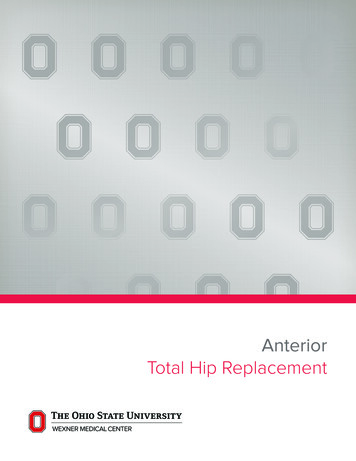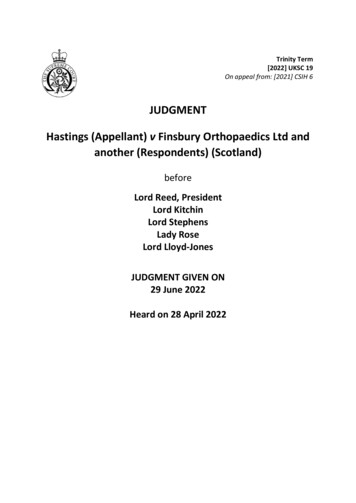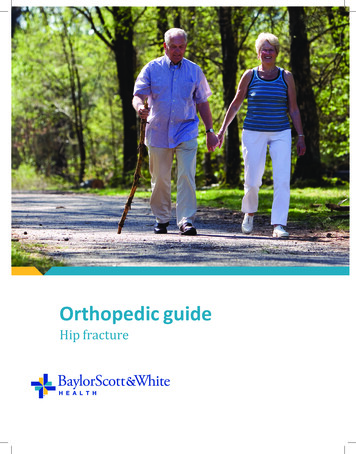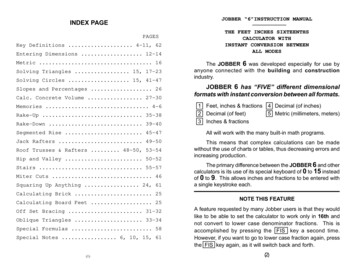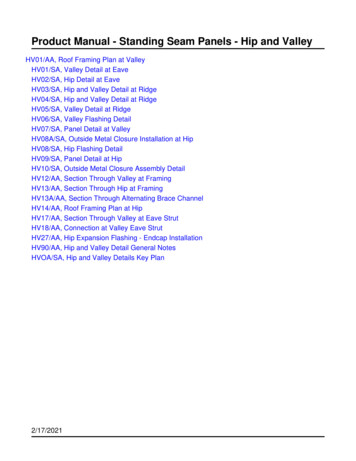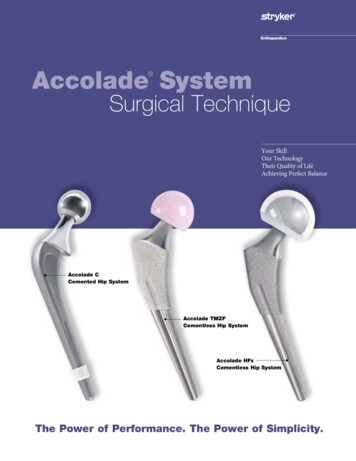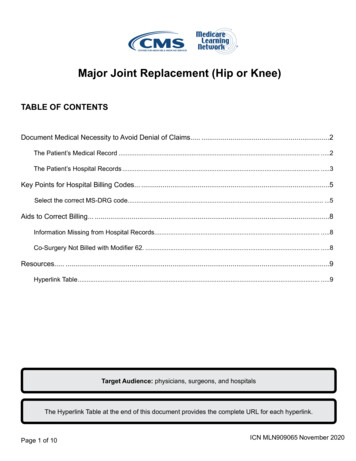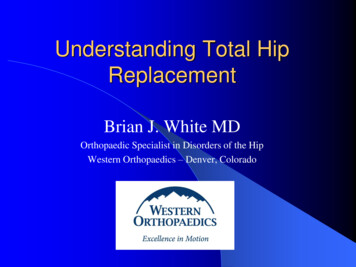
Transcription
Understanding Total HipReplacementBrian J. White MDOrthopaedic Specialist in Disorders of the HipWestern Orthopaedics – Denver, Colorado
Introduction This is designed to provide you with abetter understanding of: Anatomy of the HipRisks and Benefits of Total Hip ReplacementExpectations of the procedure
My Training Washington and Lee University Georgetown University School of Medicine Medical DegreeNYU/Hospital for Joint Diseases BA ChemistryOrthopaedic Surgical ResidencySteadman-Philippon Research Institute: Vail,CO Sports Medicine Fellowship in Knee, Shoulder and HipMentors: Dr. Steadman and Dr. Philippon
Hip Anatomy The hip is a true ball andsocket joint formed by twobony structures– The Femoral Head (Ball)– The Acetabulum (Cup) Cartilage is the cushionbetween the ball and thecup– It allows for smooth, fullmotion of the joint.
The Arthritic Hip The carilage or cushionbetween the ball and the cupwears away The hip joint becomes “boneon bone” with no cushionbetween The joint becomes stiff andpainful
Common Symptoms with anArthritic Hip Pain with: Difficulty with: Walking, twisting, pivoting and bending overPutting on shoes and socks, shaving legs, getting outof a low chairLoss of function and fun activities Pain worsens with time and more use
Non-operative strategies foran arthritic hip NSAIDS as needed for pain Modification of activity to avoid pain Physical Therapy Hip injections- typically not as helpful as they are in theshoulder or the knee, so I will rarely recommend them.They can be helpful though sometimes to try and getback to a more functional baseline if there has been anacute decline.– They can not be given within 3 months of your total hipreplacement because they can increase your risk of infection.
When is it time to have yourhip replaced? Your pain is experienced daily and gettingworse You have already modified your activityand lifestyle and are not happy with therestrictions that you have You are getting upset because the pain andrestrictions are getting to be too excessive This is an elective procedure – YOU decidewhen it is time to move forward this
What type of hip replacementdo I perform? Posterior approach There has been no clinically proven benefit to otherapproaches. I believe this is the best approach.This allows me to get your total hip in the mostperfect position (this has been proven to affect thelongevity and durability of your total hipreplacement)The anterior approach can create unfixable problemswith tendons and nerves and is more oftenassociated with incomplete incorporation of yourfemoral component and fracture of the femurNO METAL ON METAL components
Total Hip Components: Biomet G7 OsseoTi Cup Smith and Nephew SynergyHA/Porous Stem or theDepuy Summit Oxinium or Biolox CeramicHead Zimmer Vivacit-E ultra highmolecular polyehylene liner Screws to hold the cup inplace while it incorporates
Dual Mobility Total Hip Occasionally, I need to use this inpatients with a higher risk fordislocation:– EDS, Extensive spinal fusion to pelvis,very flexible hip before surgery I use the same stem, cup and ballThe bearing is different: The ballis within the liner that movesinside of the cup giving a largerarc of motionThis may wear out faster than astandard total hipMetal Liner– I don’t use this in people who are highlysensitive or allergic to metalsStandard Total Hip Replacement: Theplastic liner locks into the cup.Dual Mobility: The plastic liner popsonto the ball and both the ball and theliner move within the cup.
Cosmetic Wound Closure I use the Prineo wound closuresystem. It is a mesh covered with a gluethat gives strength to the closureand also makes your woundwaterproof to reduce yourinfection risk. I do not use this in people whoare sensitive to adhesives ortapes as they can have a blistertype reaction to this.
Durability of a total hipreplacement 80-90% should last 15-25 years if usedresponsibly– Simulator studies may suggest 25-30 years but theyhave been implanted in humans for only 15 years. All of my chosen components have an excellenttrack record Total hip replacement remains the bestprocedure we have in Orthopaedics It very reliably takes away pain and improvesfunction
What activity can you do aftera total hip replacement? Walking, elliptical, hiking Aerobics, Yoga and Pilates Cycling Skiing Golf, doubles tennis I recommend against running
Complications of Total HipReplacement Infection Leg length discepancy Dislocation Blood Clots Fracture
Infection Rare, occurs in 1% of cases Risk is increased with Diabetes, Smoking and Obesity If it occurs, additional surgery is required combined with severalmonths of IV antibiotics to try and retain your total hip replacement Risk is reduced by: Antibiotics before and after surgery and oral antibiotics afterSterile technique and clean hospitalAntibiotic solution used during surgeryAntibiotic powder placed behind your componentsAfter surgery: Take antibiotics before any medical, dental or surgical procedure to protectyour hip ( I recommend this for life) 2 grams of Amoxicillin 1 hour beforeAggressively treat any infections in your body if they occur (ie: urinarytract, skin infections, mouth infections) so that your hip does not get infectedsecondarily
Leg Length Discrepancy An arthritic hip typically shortens that legbecause of the loss of cartilage thicknessand deformity to the femoral head A total hip will typically lengthen the hip toits original length I use a computer program to plan yourprocedure to minimize the potential of overlengthening your leg My goal is symmetry when this is possible
Dislocation This can occur because with a total hipreplacement the ball is smaller than your originalball (femoral head) The following positions are avoided for 6-8 weeksafter your hip is replaced to ensure stability: Occurs in 2% of total hip replacements, this can be higher ifyou are not fully arthritic preoperatively as you have morebaseline motionHip Flexion more than 90 degreesCrossing your hip across the midlineInternally rotating your hipAfter 6-8 weeks, 1 or 2 of these positions can becombined but all 3 at once should be avoided
Blood Clots 1-2% of total hip replacements I use Aspirin 325 mg 2 times per day for 4 weeks andleg pumps for 4 weeks after surgery to minimize thisrisk If you have a predisposition to blood clots or have hadone in the past, please let me know as I may makesome changes to your postoperative medications anduse more aggressive blood thinning medications.– There is a balance-if the blood is too thin you canget a hematoma, which is a collection of bloodaround your hip that can increase your risk ofinfection.
Fracture This occurs rarely when the stem isplaced. The components, especially thefemoral stem are pressed into thebone and it needs to be a tight,wedge fit. Rarely, the wedge fit of the stem cancause a small crack in the top of thefemur. If this occurs, a wire isplaced around the top of the femurto prevent the crack from extending. I then have you limit the amount ofweight you put through your hip for6 weeks so the stem can incorporateproperly.
Hospitalization I perform my surgeries at Porter Adventist Hospital I do not like surgery centers for this operation. I do notbelieve total hip replacements should be sent home thesame day. It can be too overwhelming for you and yourfamily. All are performed on Monday or Tuesday Patients go home or to a skilled nursing facility betweenWednesday and Friday This determination is made in the hospital based on howyou do and what you have for your support at home. I amflexible. You will not feel rushed to go home-I truly wantyou to feel safe and comfortable before you leave thehospital.
Things to do before your total hip Raised toilet seat Shower chair or bench Get your body weight to an ideal position 4-5 times your body weight is put through your hip with useLosing weight will improve the longevity of your hip andallow you to get around better immediately after surgeryIt will also allow for a smaller incision and reduce your riskof infectionTake care of any dental procedures before If you have any loose or diseased teeth, these must bepulled or treated before your total hip – this represents asignificant risk factor for infection
What to expect Full weight bearing as you tolerate Crutches, cane or walker for 2-4 weeks asyou need for balance and support Return to work in 3-6 weeks depending onyou and your work (more manual or heavywork will take longer) Normal daily function by 2 months Full recovery by 4-6 months
Physical Therapy Physical therapy after your total hipreplacement is critical to get the full benefit ofthis procedure At home therapy is arranged in the hospital for1-2 weeks until you are mobile enough foroutpatient physical therapy (if you need it) Outpatient PT- my office can makerecommendations for you if you do not alreadyhave a therapist This can last for 2-6 months depending on individualneeds and goals
Post-opertive Followup 2 weeks 8 weeks 6 months 1 year and then every year after to checkyour x-ray and prosthesis
My Commitment When a patient decides to have surgery withme, I take that responsibility very seriously. Iput everything I have into every surgery that Iperform to ensure that my patients have thebest possible outcome.
Thank you I hope this has allowed you to betterunderstand your diagnosis and what total hipreplacement could do for you. Total hip replacement remains the best andmost predictable surgery we have inOrthopaedics Please feel free to call us if you have anyfurther questions. 303-321-1333
Durability of a total hip replacement 80-90% should last 15-25 years if used responsibly -Simulator studies may suggest 25-30 years but they have been implanted in humans for only 15 years. All of my chosen components have an excellent track record Total hip replacement remains the best procedure we have in Orthopaedics
